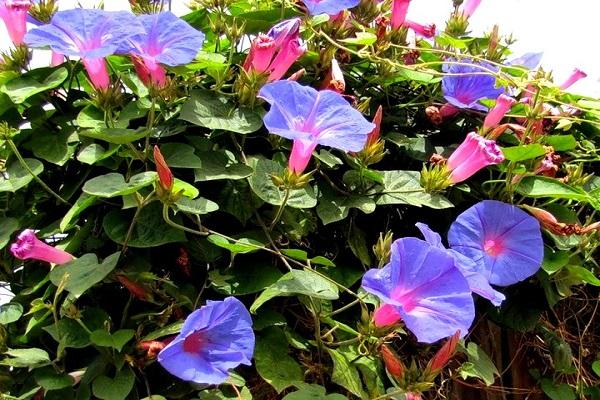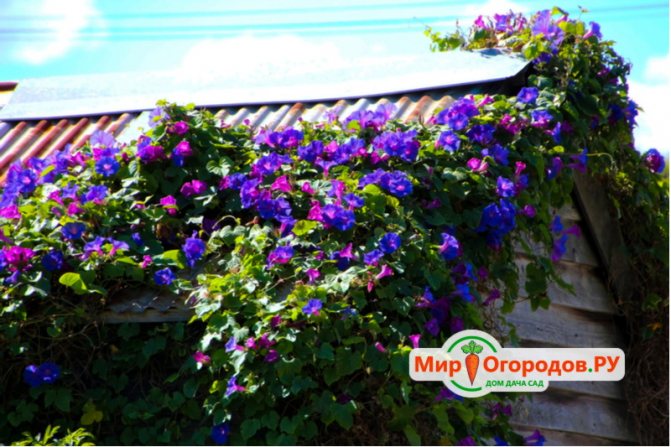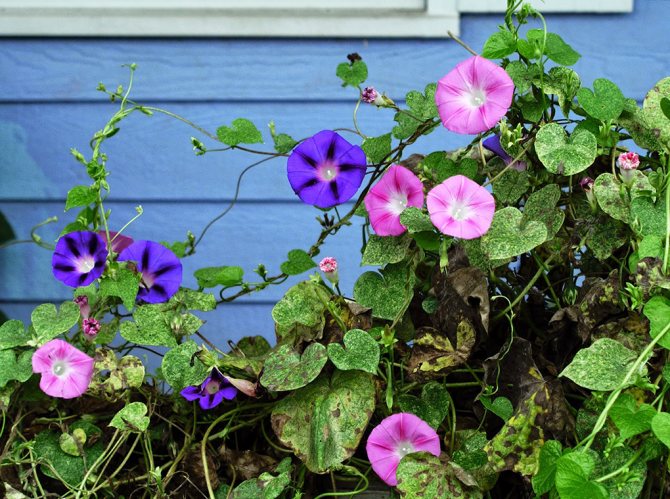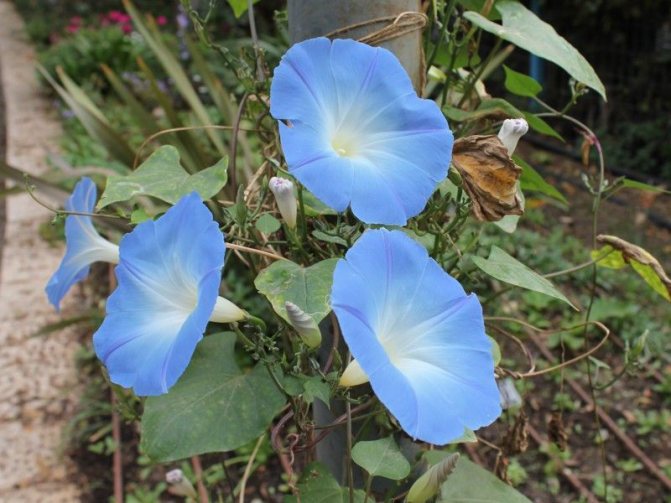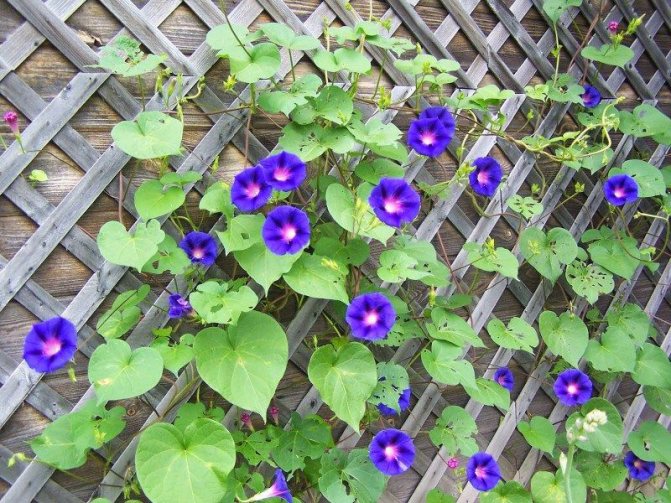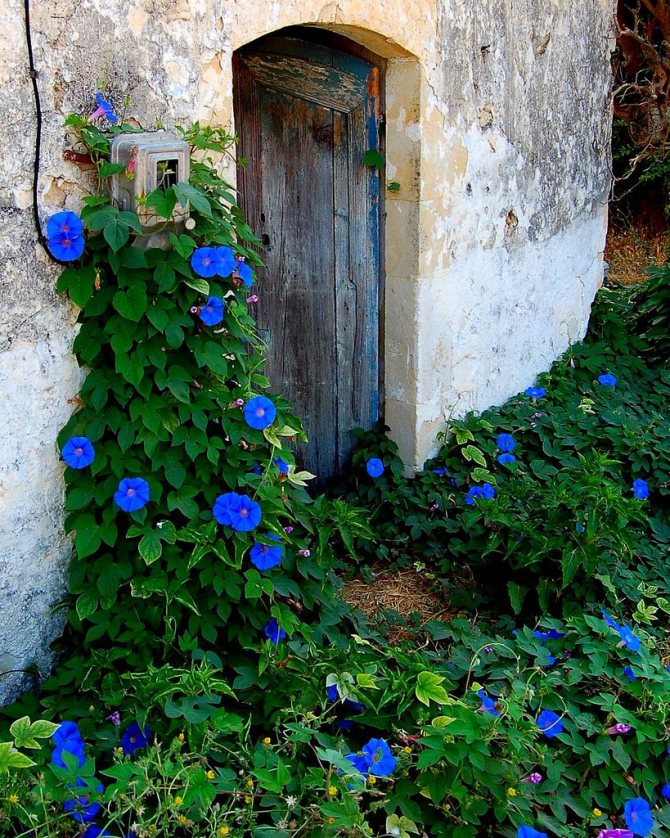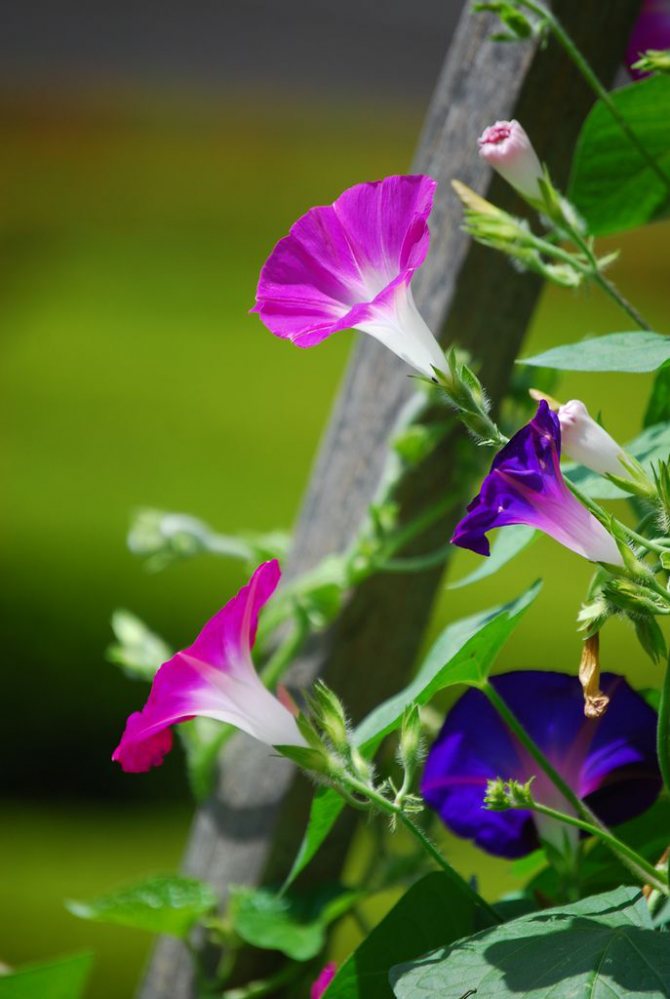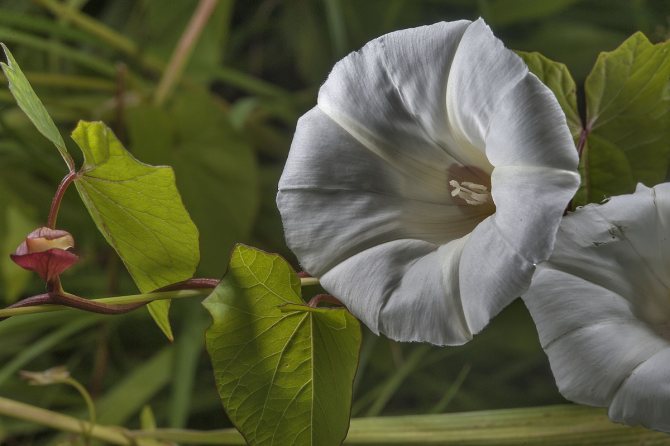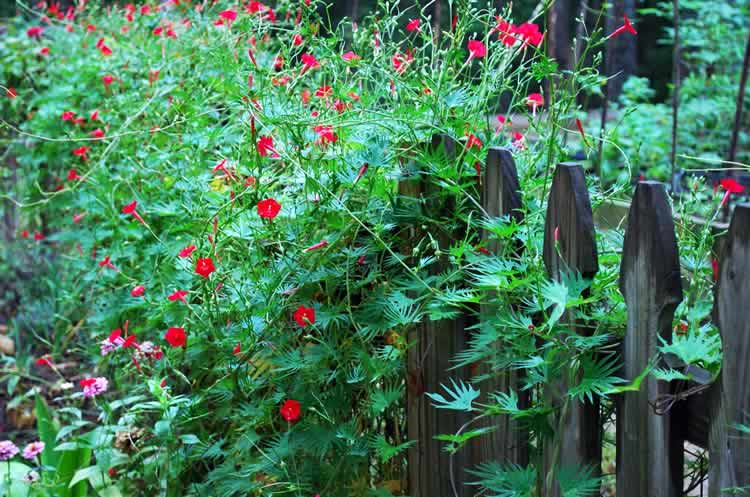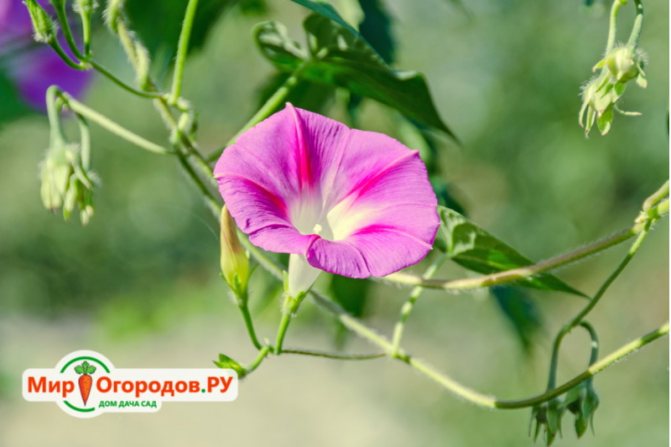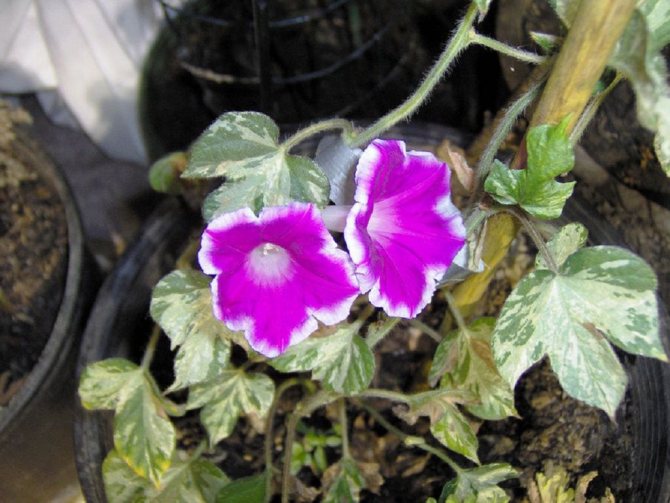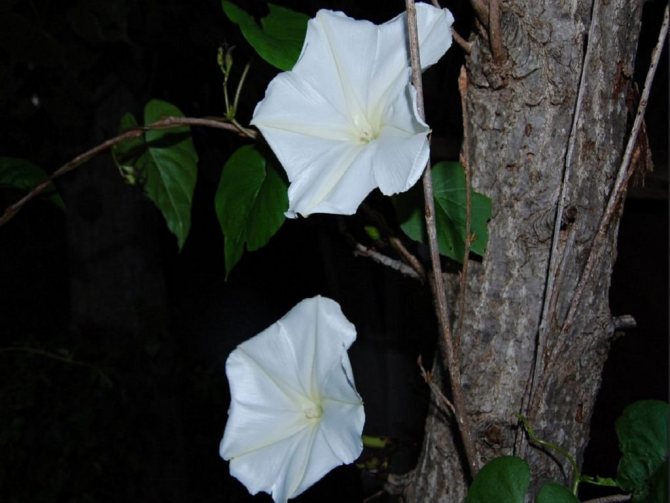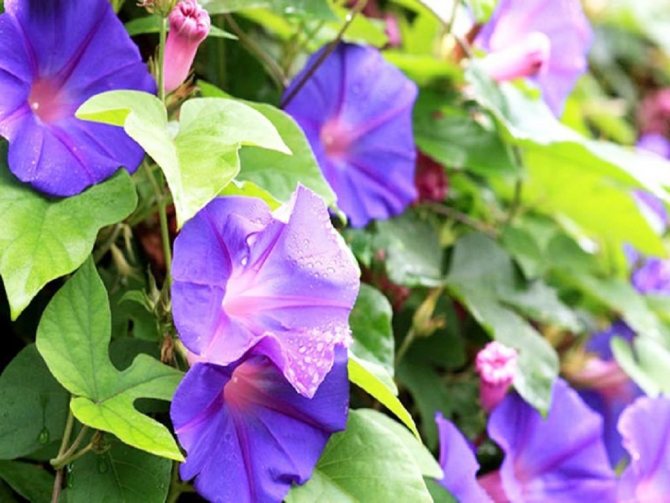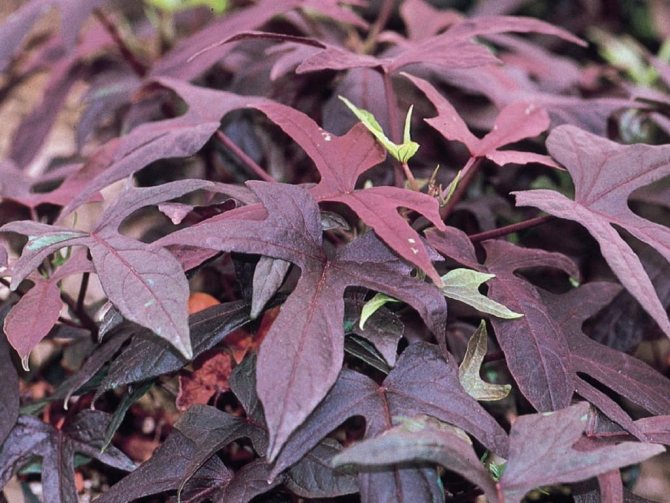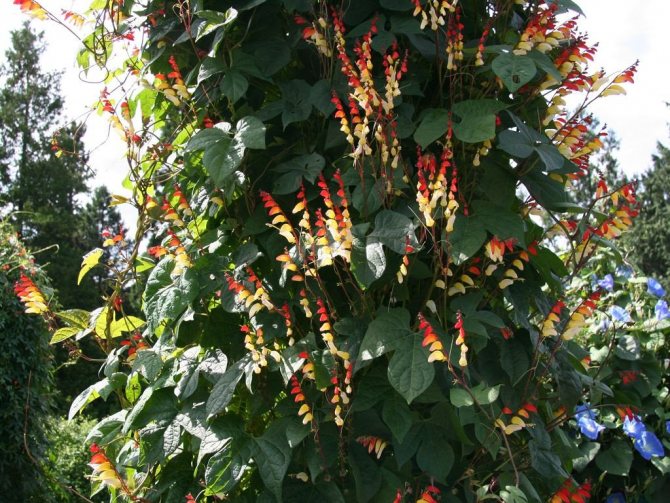Ipomoea, which are often grown in southern Russia, are annual or perennial herbaceous vines. They bloom profusely, forming bright, funnel-shaped, very short-lived flowers that usually open in the morning and wither just after noon. Ipomoea bloom in summer and early autumn, depending on the sowing time and conditions.
Morning glory
Ipomoea are grown in a sunny, sheltered from the winds in the open field. In cool summers, Ipomoea indica (Indian morning glory) can grow poorly outdoors, so it is often recommended for winter gardens. The most cold-resistant and therefore widespread species in our country is I. purpurea (I. purple). The seeds of many species are poisonous.
The most popular species and varieties with photos
In the genus Ipomoea there are more than five hundred representatives, which are liana-like grasses, shrubs and shrubs. Among them, there are two edible varieties: sweet potato and water spinach. It is interesting that the enemy of the farmers, the field bindweed, is also a close relative of the decorative morning glory. In culture, flower growers grow only 25 species of morning glory, but taking into account breeding achievements, varietal diversity is difficult to imagine. Briefly about the most interesting and famous types and varieties of flowers.
Morning glory
The moon-flowering morning glory (Ipomoea noctiflora) comes from the American tropics and is a nocturnal vine. Her height is from 3 to 6 meters. Heart-shaped, and three-finger at the ends of the shoots, the leaves are so tightly adjacent to each other that light and water do not pass through them.
Fifteen-centimeter, snow-white flowers have a strong almond scent. They usually appear before sunset, opening with a clapping sound, they live only one night. morning glory blooms from mid-summer to frost, has been cultivated for more than two centuries. Suitable for decorating nightclubs and discos. This morning glory loves nutritious soils, but thrives best on moist loams.
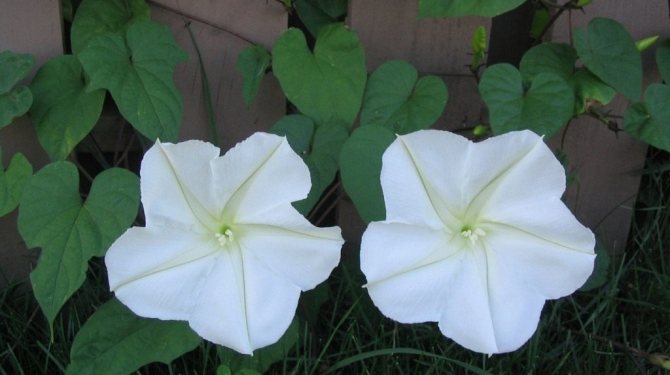
Morning glory
Ipomoea purple
Purple morning glory (Ipomoea purpurea) - South American tropicana, growing up to 8 meters. Its stems and heart-shaped, long-petiolate leaves are covered with a short downy. Seven centimeter flowers grow in clusters. In nature, they are purple, but thanks to selection, red, purple, pink flowers with white centers have been bred. Bloom from mid-summer to mid-autumn. It has been known in culture for more than three centuries, every year the number of varieties is growing. Such varieties are popular:
- Scarlet's Star - cherry flowers with white edging;
- Scarlett O'Hara - with red flowers;
- Grandpa Otts - dark purple;
- Milky Way - spotted white-pink flowers;
- Caprice - crimson;
- Kniola black knight - deep burgundy with a pink center.
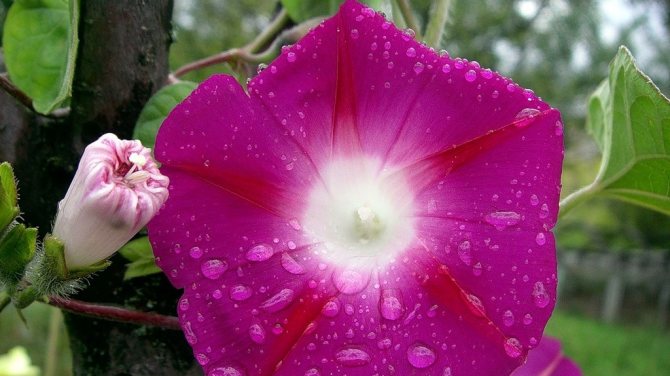

Ipomoea purple
Morning glory Nile
Morning glory Nile (Ipomoea nil) - Asian tropicana, bindweed three-meter vine with a branched stem and oval leaves. Ten centimeter flowers are red, purple, blue, blue, pink, and their core is white.
The bud opens early in the morning to last until noon. Then the flower disappears. The flowering of the bush is observed from mid-summer to mid-autumn.
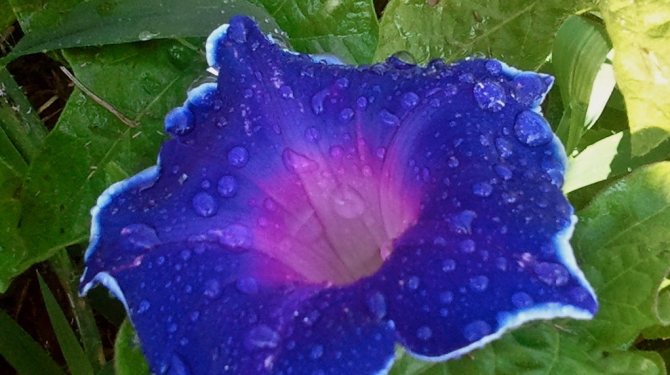

Morning glory Nile
Ipomoea ivy
Homeland Ipomea ivy (Ipomea hederacea) - the American tropics. On three-meter shoots, trifoliate leaves, elongated with teeth at the ends, grow. Five-centimeter flowers are blue with a light border, red, pink or burgundy. They appear in the middle of summer and delight flower growers until frost.
Although the ivy-shaped morning glory has been bred for more than three hundred years, it is not popular in breeding. Varieties of rare beauty with large flowers have been bred: dark purple with a light border and white. The most interesting variety, Roman Candy, is famous for its decorative green leaves with white specks and cherry-white flowers.


Ipomoea ivy
Morning glory of Cairo
Morning glory (Ipomoea cairica) is found in tropical Asian, African and Australian forests. Curly, rounded smooth shoots climb to a five-meter height. Leaves are oval and dissected. Flowers of six centimeters grow several pieces in a bunch. They have snow-white or bright colors, there are so many of them on the stem that the bindweed resembles a flowering carpet.
Flowering is observed for three months - from July to September. After that, the tubers are usually dug up and stored indoors in loose soil during the winter.
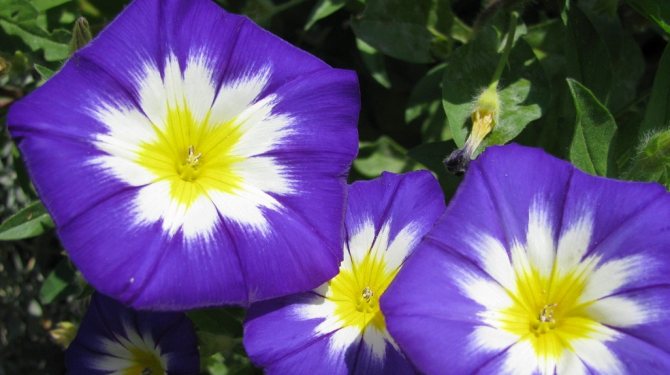

Morning glory of Cairo
Morning glory tricolor
Ipomoea tricolor comes from the American jungle. The branched stems rise to a height of five meters. Large wrinkled leaves sit on long legs. Flowers of ten centimeters grow in several pieces in a common outlet. Blooming in the early morning, they are sky blue with a white core, and by the end of the day, before wilting, they turn purple-pink.
The decorative view has been cultivated for almost two hundred years, many varieties have been bred:
- Blue Star - with white and blue flowers;
- Summer sky - blue flowers with white specks;
- Wedding bells - milky white with yellow;
- Sky blue - blue or purple flowers with a white-yellow core.
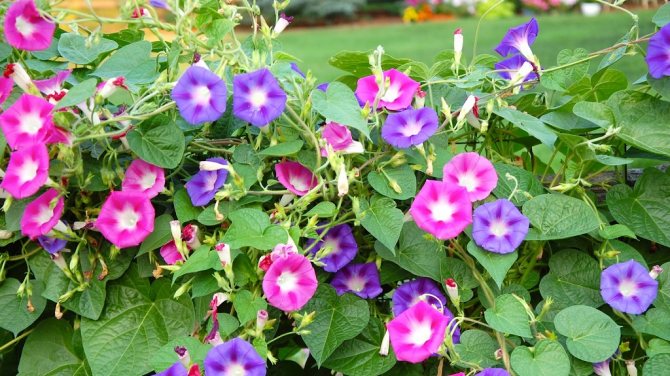

Morning glory tricolor
Morning glory Kvamoklit
Morning glory Quamoclit is represented by several varieties:
- Slaughter's Kvamoklit. She has a one and a half meter stem, light green seven centimeter leaves, bright red flowers that appear from July to September. Propagated exclusively by seeds.
- Cirrus or cypress vine with openwork, light green leaves similar to cypress feathers. Flowers are small, star-shaped, appear in July-September. Most often they are red, but they are pink or white.
- Fiery red with a thin three-meter stem and heart-shaped leaves. Bright and small scarlet flowers with a yellow receptacle appear only for a month in July.
- Fiery red ivy with decorative leaves and larger flowers that last for two months.
- Lobed or Spanish flag originally from the Mexican south. Its twisted three-meter shoots are reddish, the leaves are heart-shaped. Flowers in the form of droplets, reaching a size of 3 cm, are grouped in 40 cm brushes. During flowering, the flowers change color from red to pale yellow or almost white. Flowering lasts from late summer to October.
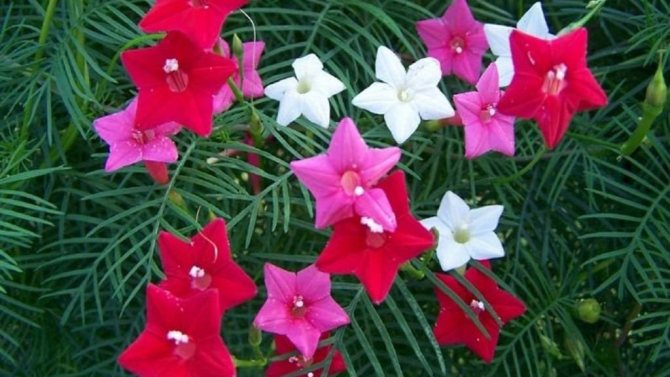

Morning glory Kvamoklit
Attention! The seeds of some species of morning glory contain psychotropic alkaloids ergine and its derivatives. These seeds were used in their manipulations by Indian shamans.
Popular varieties
In our latitudes, only a few varieties can be considered the most common:
- morning glory - it stands out with rather large white flowers up to 12 cm in diameter and a shoot reaching 6 meters in length;
- morning glory - a characteristic feature of this variety is the feature of strongly branching, and the flower petals from the center to the edge of the funnel-shaped flower are colored in three contrasting shades - yellow, white, blue or light blue, purple, pink;
- morning glory purple - refers to the species with the longest shoots up to 8 meters long, flowers up to 7 cm in diameter, colored from purple to dark lemon shades;
- blue - the variety is impressive in the photo with its pure blue color with rather large flowers, which look great in combination with white morning glory;
- kvamoklit - differs in the shape of the leaves, as well as flowers and height of the shoots.
Most gardeners prefer purple terry morning glory. It can be most often seen on personal plots.
Planting dates
The process of growing morning glory begins in mid-spring. The ornamental plant is perennial morning glory, not frost-resistant, so in central Russia it is necessary to start annually with seed germination.
Sowing preparation
After harvest, the seeds are stored for several years. They are first soaked in warm water for several days. If they are too dense, then they are pierced with a needle (scarified), and then soaked again until they swell.
It is important to find the right soil.
- African migrants need soil for succulents, which includes fine expanded clay.
- For American Tropicans, equal proportions of peat, vermiculite, coconut fiber, a little fine expanded clay, and leaf humus are added to the soil mixture.
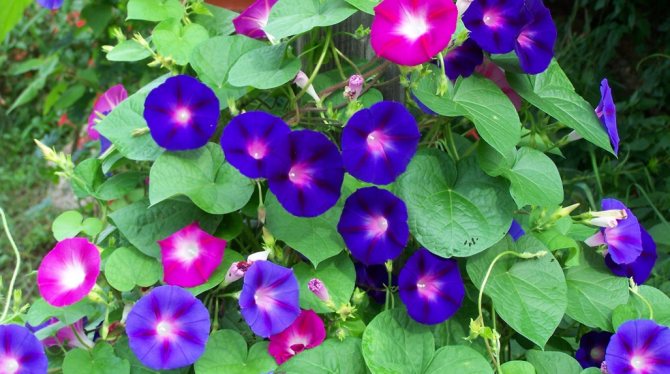

Ipomoea is grown in seedlings
Growing seedlings
Prepared seeds in pairs are placed in cups with an earthen substrate, covered with glass or film. Such an impromptu greenhouse is periodically ventilated and watered. They are kept at a twenty-degree temperature until seedlings appear in a couple of weeks. Then the film is removed.
When the plants reach a height of 15 cm, a string is attached to the sprout, securing its second end at the top. The liana climbs along it. As they grow up, they are transferred a couple of times into a large container, while pinching the tops.
When the plant has at least 4 full leaves, it can be transplanted into the ground. The seedling must be carried along with a large clod of earth. This is important because the morning glory doesn't like transplants.
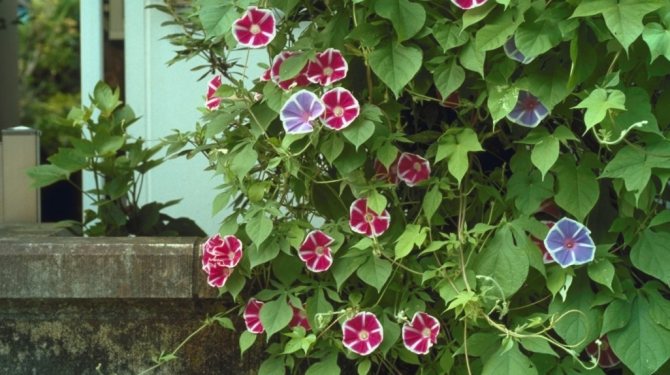

A young morning glory is planted after the appearance of 4 true leaves
Application in the design of the site
Perennial morning glory is used for decorative purposes for vertical gardening. A climbing plant can be launched along arches and pergolas, cones, decorate gazebos, and make green fences. Perennial morning glory will quickly disguise old and outbuildings. Plants can be guided or pruned to create the desired shape.
Long-term morning glory in the design of the site is combined with:
- sweet peas;
- decorative beans;
- Kampsis;
- hops;
- wild grapes.
In flower beds, Ipomoea sweet potatoes are planted with petunias, pelargoniums and coleus. Ipomoea can be transplanted from pots into open ground at any time. Perennial morning glory is not recommended to be planted next to light-loving plants.
Planting morning glory in open ground
The time to transplant to a permanent place in the garden should be chosen so as not to fear spring frosts. This is usually done in the second half of May.
Drop off location
Partial shade is best for planting morning glories. Strong shading leads to a slowdown in the growth of the vines and shredding of flowers. But bright light is also not good for morning glory. Its already short flowering is reduced at the same time. The flower shrinks in the direct sun. This impairs the decorative effect of plants.
When planting creeping vines near the walls of buildings, it is necessary to provide that rainwater from the roof does not fall on them.
Attention! Thin stems of liana easily get confused and break in strong gusts of wind. Therefore, when planting morning glory, drafts should be avoided.


Morning glory does not like bright sunlight and prefers partial shade
How to plant seedlings
This thermophilic plant is planted at a stable average daily temperature above 12 degrees. The site before this is fertilized with organic matter and dug up. The distance between the pits should be at least a third of a meter.
The planted vines are covered with loose soil, and sprinkled on top with a five-centimeter layer of peat mulch. Above the shoots, a support is built from a lattice, twigs, or a fishing line is pulled, fixing its lower end on a peg at the base of the vine.
Plant description
Morning glory is an annual or perennial plant in the form of a vine, grass, shrub or tree. The ability to curl is reflected in the name of the flower, which is translated from Greek as "like a worm".
The plant is used universally for decorative purposes, and some varieties (trampoline and water trampoline) are food crops. All decorative varieties of morning glory in European countries are called "morning star".
Most varieties have heart-shaped leaves as well as long shoots that can curl around a support. From June until the beginning of frost, beautiful funnel-shaped flowers are formed on them, resembling small gramophones.
With the right pruning and growing method, planting a perennial variety of Ipomoea turns into a real blooming and fragrant green carpet, which is so often depicted in pictures.
Necessary plant care
In the Moscow region, planting and caring for the morning glory is carried out as for any flowering summer plant. As a perennial, it grows only in warm climates.
Ipomoea is often planted not only in the garden, but also on the balcony. Caring for a vine on the balcony is to protect it from the wind: it must be glazed. Each plant should have about 3 kg of soil. Timely watering and complete feeding are important.
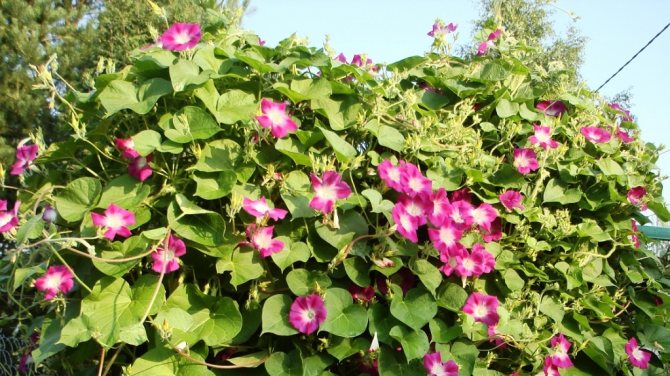

Caring for morning glory is no different from caring for a flowering annual
Fertilizing and feeding Ipomoea
Caring for morning glory is simple: water it regularly, avoiding stagnation of water at the roots. Moreover, in the summer, the earth should not be allowed to dry out, and in the fall - when its upper layer dries up.
Top dressing is carried out during the growing season 2 times a month with fertilizer for ornamental flowering plants or for cacti. But it is important not to overdo it: an excess of fertilizing leads to increased growth of foliage to the detriment of flowers. Observe the same concentrations as for indoor flowers.
Nitrogen fertilizers are applied in the form of root dressings. Foliar dressing is sprayed through a spray bottle. Phosphate fertilizers are suitable for this purpose. They are introduced into the soil even when the bushes are planted, and then sprayed during their growing season.
During flowering, fertilizing with microelements is useful. At the same time, vines grow lush, resistant to weather changes and diseases.
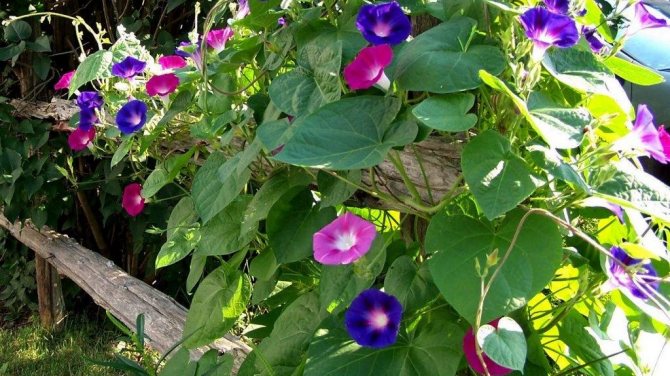

Morning glory needs regular feeding
Support for creepers
A climbing plant with a thin stem cannot grow on its own and needs support and support to give direction. They can be different: simple and curly. It all depends on the functions of the plant and on the creative ideas of the gardeners:
- A pyramid of a dozen metal rods diverging at an angle, fastened at different levels by parallel rings. Creates a vertical accent in the garden.
- A thick fishing line stretched parallel to the ground for easy removal of plants in the fall.
- A hollow wooden cone that can be used in winter to protect young Christmas trees.
- Morning glory can climb a nearby tree. Often the plant is planted along fences and fences.
- Curls along a special garden netting or lattice of a gazebo or other garden structure.
- Volumetric figures made of metal mesh, wooden arches or pergolas, pillars arranged in a whimsical order.
Morning glory Nile
Annual liana, reaching a height of 3 meters. The leaves on it are opposite, have an oval or heart-shaped shape and long cuttings. The flowers have a characteristic funnel-shaped shape, they can reach a diameter of 10 cm.The color depends on the variety, there are white, blue, pink, red and purple specimens. There must be a snow-white core.


Although the lifespan of one flower is only a day, the Nile morning glory varieties bloom magnificently until the first autumn frost - from July to October. A characteristic feature of these varieties is sterility, so they multiply by cuttings.
All varieties of this species are very thermophilic, therefore, with a cloudy and rainy summer, you can not wait for their flowering. At the same time, they grow well in the Russian climate without undue efforts on the part of gardeners.
Ipomoea Nile is distinguished by a large varietal variety:
- Serenade;
- Early Call Mixed series;
- Chocolate;
- Morning call.
Interesting! Japanese breeders made a great contribution to the development of new varieties of this species. Ipomoea Nile is very popular in Japan and got the name "asagao", which can be translated as "morning face".
The varieties of this species are quite diverse and differ from each other not only in the color of the flowers, but also in their size, terry, flowering duration and growing method.
Possible diseases and pests, control of them
Morning glory suffers from fungal diseases (rust, rot), viruses and a physiological disease - white edema.


Ipomoea are often affected by fungal diseases.
With fungi, the cause is contaminated soil or stagnant water. Fungicides are saved from them, but in severe cases the plants have to be destroyed. Ipomoea infected with viruses are burned. Only greenhouse and indoor plants are subject to white edema.
Aphids and spider mites are dangerous for tropical bindweed. If they are detected in a timely manner, then the plants can be saved by treatment with soapy water. In advanced cases, only systemic insecticides help: karbofos, fitoverm or actellic.
Morning glory red-blue
One of the most popular types of morning glory, which is easy to care for. Vines reach 5 meters, are decorated with heart-shaped leaves and large (up to 10 cm) flowers. They are painted in a pale blue color with a white core, and in the active phase they change color to rich pink.


Flowers open early in the morning and close by lunchtime, although on cloudy days they can bloom until evening. The flowering period ends in mid or late October, together with the first frost. The most popular are the following varieties of this species:
- Early Call Mixture;
- Heavenly Blue;
- Pearly Gates;
- Flying Saucer;
- Skylark.
They are distinguished by their bright colors and special decorative effect.
Morning glory in combination with other plants and in landscape design
For landscaping, Ipomoea Batat is often used with large decorative foliage of different colors: different shades of green, yellow and red. Variegated varieties with pink or white specks on the background of greenery were bred. For flower arrangements, different varieties of such morning glory are combined.
Morning glory goes well with other plants used for vertical gardening: kampsis, wild grapes, ivy, hops. It looks elegant next to deciduous trees.
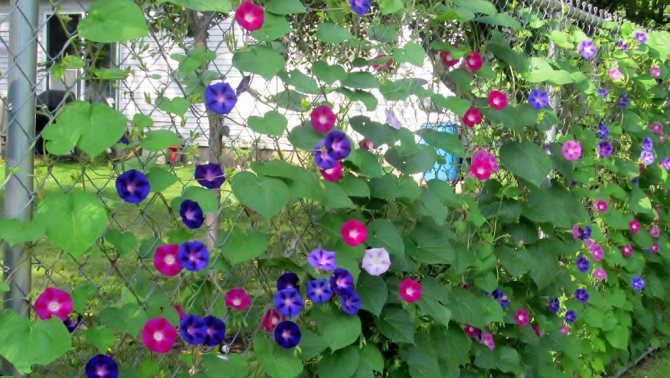

Morning glory is often used for vertical landscaping
In landscape design, it serves to decorate open terraces and gazebos. It is often placed next to antique-style buildings or lanterns, and also decorates walls, fences, gates, columns.
In horizontal decoration, plants of contrasting shades look spectacular, decorating one surface, a flower bed, a living carpet. A picturesque living fence of plants with leaves and flowers of different colors. Enhances the effect of being adjacent to conifers.
If you twist the arch with a moon-flowering morning glory, then with the right illumination, the snow-white flowers will look like fabulous lanterns. And their amazing aroma will add even more mystery and charm to the summer garden.
The composition with flowers planted in garden vases looks great, which, if there is a frame above them in the form of a flower bouquet, will first wrap it around it, and then hang down almost to the green lawn.
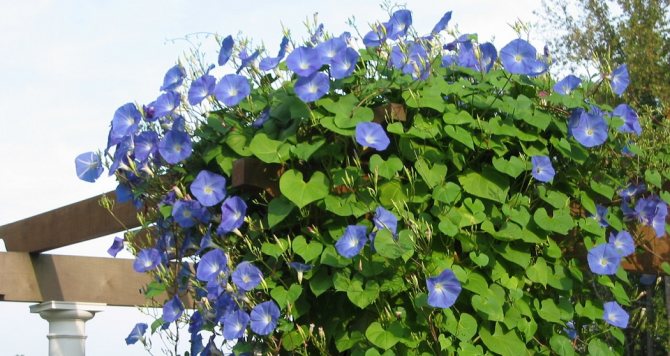

Blooming morning glory looks good on a high pergola
Description and photo
Ipomoea belongs to the bindweed family, and in total there are more than 500 species of this beautiful climbing plant in nature. South America is considered the homeland of the morning glory, and there it is cultivated as a perennial species. In our area, it is most often grown as an annual.
If you look at the photo, you can immediately notice how delicate the flowers and leaves of the flower look. In their beauty, they can overshadow many garden plants and serve as a bright decoration for a garden plot. Morning glory among the group of loach species is the largest plant.
The flower develops rapidly, grows well and blooms profusely with numerous buds. Such properties made it very popular for planting on the site as a living decor:
- alcove;
- high pergolas;
- lanterns, etc., small garden items.
Many have heard, but not everyone knowshow to properly grow a Salpiglossis flower.
Most often, morning glory is used for vertical landscaping of landscape design. Ipomoea leaves can be of different shapes:
- oval;
- round;
- heart-shaped.
Any form of foliage has a rich green color. In the open field, the plant blooms in early summer and blooms violently before the onset of frost. Ipomoea seeds are in a closed capsule, and when fully ripe, the capsule cracks and the seeds crumble.
Morning glory in autumn
Autumn morning glory retains its decorative effect until frost is no longer due to flowers, but due to multi-colored leaves.
How and when to collect morning glory seeds
Seeds are harvested from the lower buds from brown bolls, which should dry out and open slightly. Do this a month after flowering. The seeds are slightly dried and put in paper bags, on which labels with the names of the varieties are glued. They can be sown over the next three years.
Attention! The seeds of some types of garden morning glory (for example, sky blue) are poisonous.
Morning glory Kvamoklit
A variety of morning glory Kvamoklit came to us from the countries of South America. These are long vines, decorated with rather small funnel-shaped flowers, traditionally shaped like gramophone. This species is one of the most popular in Russian floriculture, and includes several subspecies.
Pinnate
Morning glory kvamoklit peritaya looks nothing like other popular varieties of this plant. Its leaves are strongly dissected, small and delicate. The flowers are also small - only up to 1.5-3 cm in diameter. The color of the flowers may vary depending on the variety - white, pink, red. The flowering period for representatives of this subspecies is from mid-summer to September. With proper care, the vine can reach 5 meters in height.
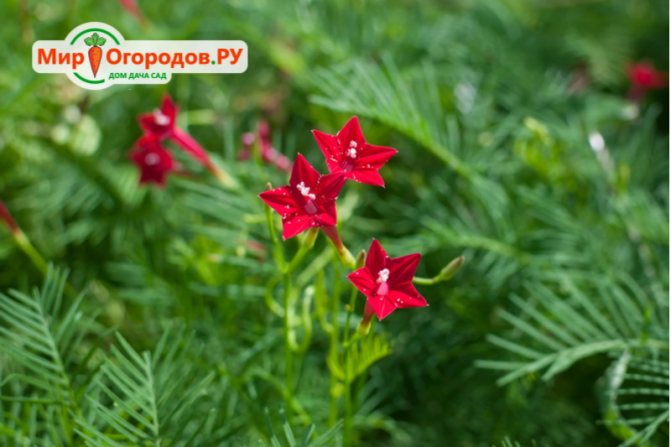

Among the features of its cultivation is the intolerance of transplants. Therefore, it is best to grow it by direct sowing into the ground. If this is not possible, the seeds should be sown for seedlings in separate containers, from which the seedlings are transferred to a permanent place with the preservation of an earthen coma.
Slaughter
Ipomoea Kvamoklit Slaughter bears little resemblance to other plants of this genus, although its flowers retain the usual shape of phonographs. The height of the liana can reach 3 meters, and the diameter of the flowers is about 2 cm. For the rich bright red color of the flowers, this subspecies of morning glory has received the name "Cardinal Liana".


Morning glory Slaughter blooms from July to September. It is propagated exclusively by seeds, which are sown directly into open ground.
Fiery red
Morning glory Kvamoklit fiery red refers to annual plants. Its stem can grow up to 3 meters in height. Liana is decorated with small red flowers, reaching a diameter of only 2 cm.


Varieties of this type of morning glory quickly lose their decorative effect, since at the end of August the flowers are replaced by ripening seed pods, and the aerial part begins to gradually die off.
Lobed
In the countries of South America, varieties of this species are grown as a perennial ornamental plant, but in our country it is cultivated exclusively as an annual. The height of the liana can reach 3 meters, the leaves are heart-shaped, consist of three lobes, for which the species got its name.


Small, up to 3 cm in diameter, flowers with protruding stamens are collected in long inflorescences that can reach a length of 40 cm. They attract attention by the fact that during blooming they change their color from rich red to orange and light yellow.
This type of morning glory can be grown by direct sowing into the ground or through seedlings - they easily tolerate transplants and bloom profusely until the first frost.
Reproduction
Reproduction of culture, depending on the species, can be carried out:
- seeds,
- cuttings,
- layering and
- tubers.
Seed propagation is described in the "Planting morning glory" section.
| You can collect the seeds yourself. It is better to do this in the fall, so that at the time of planting they are as fresh as possible. In place of a wilted flower, a box is formed, which, when ripe, becomes brown. When it opens slightly, it is cut, the seeds are poured out and used for planting the next season. |
Considering that all types of morning glory in our conditions are grown as annuals, vegetative reproduction is not used for them.
The exception is morning glory sweet potatothat can be bred indoors. It can be grafted, propagated by tubers and layering.
Cuttings
By the end of winter, from the morning glory, the sweet potato is cut into apical cuttings with 2-3 internodes and placed in water. Already on the fifth day roots appear.
The seedlings are placed one by one in special containers with a suitable soil mixture, placed in a warm, bright place.
Grown specimens, at the beginning of June, are planted or carried out in a container on the street.
Tuber propagation
Morning glory sweet potatoes can be propagated by tubers, but they only mature in the south, in areas with a long warm season.
Before freezing, the tubers are dug up and put into a dry basement with a temperature of + 5 degrees. They are stored there until February. At this time, the tubers are taken out, the buds should already awaken on them.
Each tuber is planted in a pot for germination and the development of sprouts is monitored. As soon as the roots appear on the sprout, it is carefully separated from the mother plant and placed in a separate container.
Reproduction by layering
In July, the shoots of morning glory sweet potato, which grow near the root collar, are buried in earth, leaving the top.
After 30 - 40 days, rooting occurs, the shoot is cut into separate seedlings with roots and planted one at a time.


What are vines used for, in particular, morning glory?
Anyone who is even a little familiar with landscape design knows this term: vertical gardening. That is - the creation of wicker arbors, walls and for masking objects - not without it. The simplicity of some varieties of bindweed is not a hindrance: large and small, the usual blue and original multi-colored gramophone Ipomoea can decorate any corner of the garden. Liana is especially popular among the owners of not new country houses - with the help of a plant, they give flimsy huts such a blooming look for the summer that even the owners of new cottages can envy them.
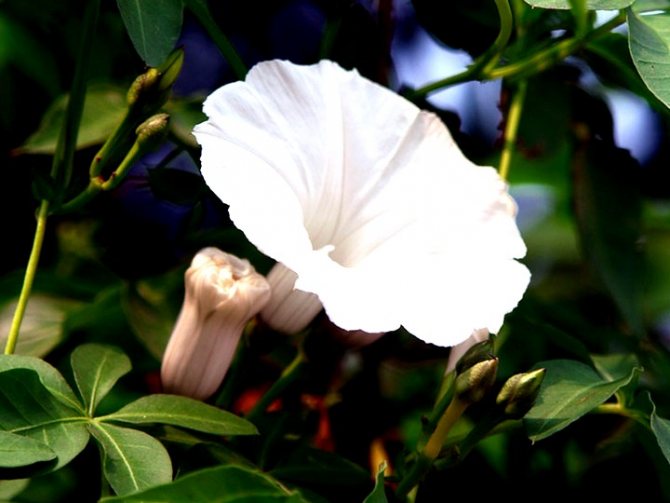

Mr. Dachnik informs: why does the morning glory not bloom?
There are many reasons for stagnant growth, all caused by different aspects. However, if all is well, subject to all the nuances, flowering should begin in July. If flowering became active later than this time, or vice versa earlier, this is normal. Time variations are normal, within 10-15 days.
If the vines were regularly examined for diseases, viruses and pests, and the flowering period begins to be delayed by more than half a month, you need to start looking for the cause of the problem.
- The first cause of stagnation may be nitrogen fertilization. It is necessary to use such an amount of top dressing so that the soil has an optimal content of this substance, if it is more or less than the norm, this can easily lead to stagnation.
- The second reason is the issue of watering. Here the situation is exactly the same. It is necessary to maintain optimal soil moisture, in case of a lack of water, the plant will begin to wilt, as a result of which this can lead to death. From an excess of moisture, a fungal disease can form, which can lead to cutting out most of the plant, and those planted nearby can also become infected.
- The third reason is non-compliance with the rules for planting morning glory in open ground. If the plant was planted later than the required time, then the process of growth and flowering can be seriously delayed, and by the onset of frost it may not be completed at all. Which will lead to a waste of time, since the plant will most likely die without blooming.
All these reasons are not critical; at the first signs of stagnation in growth, it is necessary to immediately determine where it lies. After that, the situation is easily corrected. In the case of an excess or a lack of nitrogen, various indicators that are sold in specialized flower shops will help. The situation with excess, lack of moisture is just as easily corrected. Depending on the stage of growth, it is necessary to be guided by the moisture content of the soil, leaving its top layer always slightly moist.
In case of late planting in the soil, nothing needs to be done. Moreover, to use any feeding, supposedly significantly accelerating growth. This will add another problem. You just need to give more time to the morning glory, if it does not have time to bloom before the frost, transplant it into a separate pot, and place it in a greenhouse. This will allow you to finish growing in favorable conditions for her, even if it's already mid-autumn outside.
Growing
In most cases, morning glories are grown using seeds.... The vegetative reproduction method is very rarely used. This is explained by the fact that the annual plant may not have time to form completely from the cuttings in the remaining time until the end of the season. Seed cultivation of morning glory has proven itself well and has been used by gardeners in Europe for more than one century.
There are two main ways of growing morning glory from seeds - by direct planting in open ground and by planting seedlings... Both have their own nuances, advantages and disadvantages.
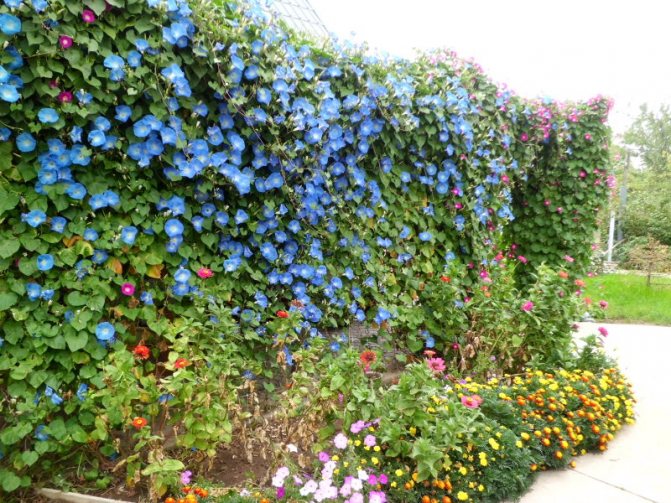

Morning glory, braiding the hedge
Of course, it is best to plant the plant directly in open ground., since at the same time we get rid of the unpleasant duty of constantly tinkering with seedlings, however, in some areas, the time for full-fledged plant growth may not be enough due to the short duration of the warm season.
Growing morning glory in seedlings also has its drawbacks. About a third of the varieties of morning glory very poorly tolerate plant transplantation, even at the seedling stage. In addition, the seedlings of morning glory have very high growth rates, therefore, such an option is not excluded that you can seriously miscalculate over time and get wildly growing plants (up to several centimeters per day), which are in a box with seedlings, while on the street it is still there is a temperature around zero.
In general, to choose a method of growing morning glory, it is necessary to weigh everything well and carefully plan so as not to be mistaken with the timing of planting seeds for seedlings.
back to menu ↑
See also: Perennial flowers (33 main species): garden catalog for a summer residence with photos and names | Video + Reviews
Seedling method
It is recommended to plant morning glory seedlings at the end of March. This will allow you to get plants ready for transplanting into open ground already in early May. Before planting in the ground, the seeds must go through a stage of hatching. To do this, they are placed in water and soaked for about a day. Once the seeds are swollen, they can be planted in seedling soil.
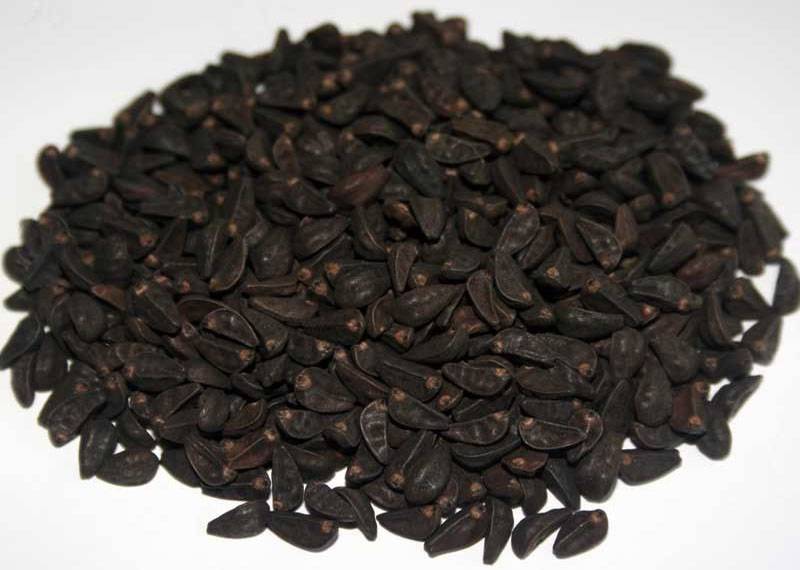

Morning glory seeds
The composition of the soil can be as follows:
- peat - 4 parts
- leaf land -4 parts
- sand - 2 parts
- humus - 1 part
Before planting seeds, the soil must be disinfected with a solution of 0.2% potassium permanganate. It is not necessary to carry out heat treatment of the soil.
The depth of planting seeds in the ground is from 1 to 2 cm. In this case, 2-3 seeds should be planted in each well. The seeds are covered and watered with a little water. In order not to wash them out, it is best to use water from a spray bottle for irrigation. After which the box with seedlings is taken to a dark and warm place.
The first shoots should appear in 1.5-2 weeks... As soon as they appear, it is necessary to take the box out to a sunny area and start daily watering the plants with boiled water at room temperature.
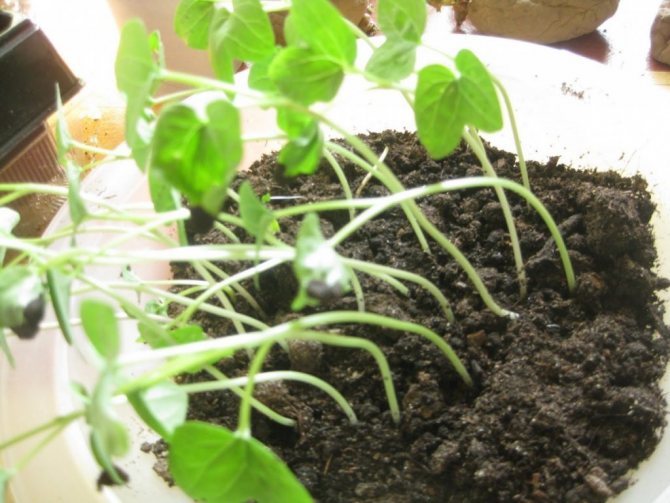

Ipomoea seedlings
When two real leaves appear, the plant is picked... It must be done very carefully so as not to damage the root system of young shoots. It is advisable to pick a plant with a relatively large clod of soil so that the probability of root damage is minimal.
A pick is best done in an individual container, the best choice of which is a peat pot, because it is he who allows you to transplant the plant into open ground with it. Thus, complete preservation of the root system is achieved during transplantation.
back to menu ↑
See also: Anemones: 25 species, features of reproduction and care, planting in open ground, forcing in winter, a description of the medicinal properties of the plant (50+ Photos & Videos) + Reviews
Landing in open ground
For any form of planting material, the soil in which the morning glory is planted must be fertilized... You can use, for example, humus, adding it in the amount of one bucket to each planting point, or you can use mineral fertilizers at the rate of 30-40 g per 1 sq. m.
Separately, it should be noted that it is highly not recommended to use nitrogen-containing fertilizers for fertilizing morning glory, since they lead to an abundant growth of green mass, however, there will be no flowers at all.
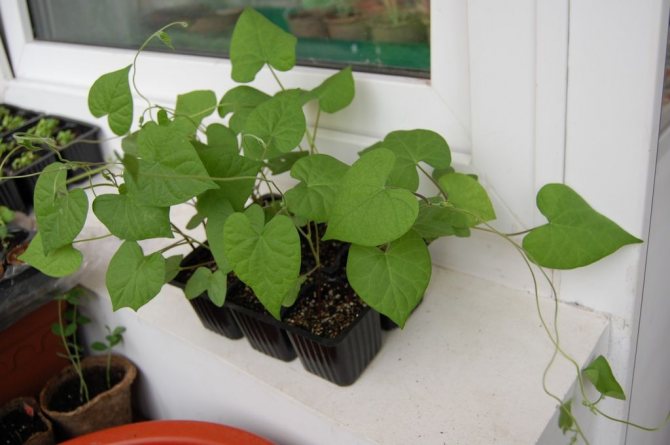

Ipomoea seedlings before planting in open ground
After the site is fertilized, dug up and loosened, you can start planting. For plants grown directly in the open field, bypassing the seedling phase, sowing in open ground is carried out in early to mid-May. At the same time, 3-4 holes are made in the places where the plants are supposed to be grown, in each of which 2-3 seeds are planted. Over time, they can be ordered, or, in extreme cases, transplanted. The seeds are covered with earth and watered.
Seedlings are usually planted in the ground from mid-May and later. The main criterion according to which seedlings are already mono planted: increase in air temperature up to + 16-18 ° С.
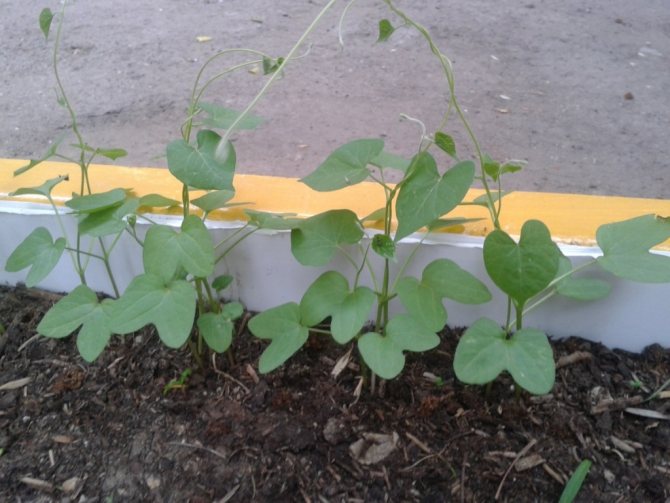

Morning glory, planted in open ground
Holes for plants are dug at a distance of about 20-30 cm from each other, their depth should correspond to the size of the earthen coma with which the seedling bush is transplanted. After planting is done, the plants are watered and sheltered from the wind for the first 2-3 days with the help of some kind of fence.
Morning glory in winter
In middle latitudes, morning glory is cultivated as an annual plant. In this regard, in the autumn, after flying around the foliage, shoots can be cut off, and the site should be digged, do not forget to select and destroy all rhizomes. In springtime, sow the seeds again, and you will have a spectacular vine again.It should also be noted that morning glory reproduces well by self-seeding, therefore there is a high probability that in the place where it grew, friendly shoots of this vine will appear in spring.
Growing morning glory from seeds
Ipomoea from seed - sowing
Morning glory is propagated by seeds that remain viable for three to four years after harvest. Ipomoea seeds are sown into the substrate in mid-May, but they are preliminarily scarified (the integrity of the shell is violated) or simply soaked for a day in 25-30 ºC water for swelling. If the seeds do not swell, their shell must be pierced with a needle and soaked again.
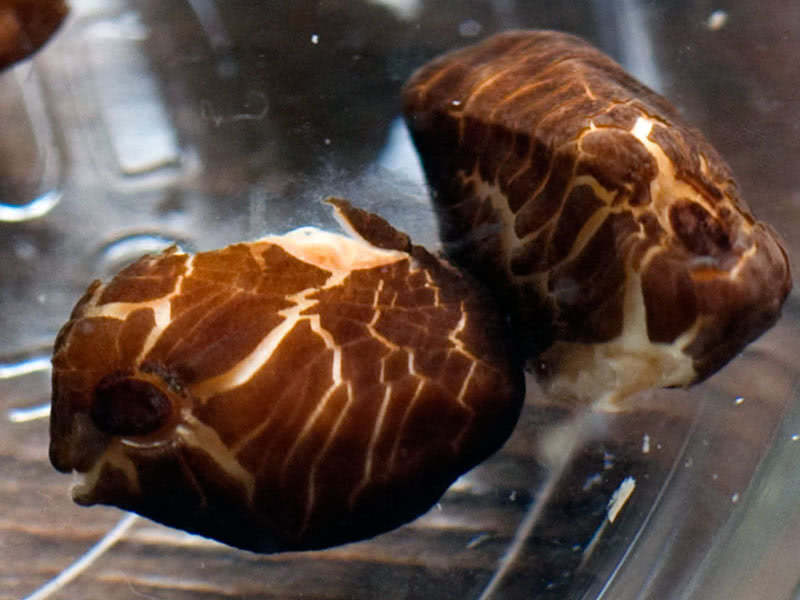

Particular attention should be paid to the composition of the soil, and this is where difficulties arise, since each species needs a specific substrate. Species of African origin prefer soil for succulent plants with the addition of fine expanded clay, such soil will not work for American varieties, and you will have to make a mixture of two parts of leaf humus for them, adding one part of peat, vermiculite, coke fiber and half a part of fine expanded clay to it.
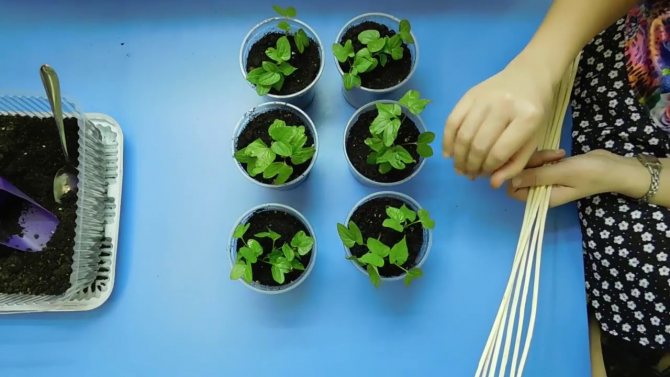

The seeds are planted in small cups with a substrate, two to four in each and covered with glass or film to make a greenhouse. Water the soil as needed, ventilate, remove condensation, observe the 18-20-degree temperature regime, and seedlings will appear in 10-12 days.
Ipomoea seedlings
When the seedlings grow up to 15 cm in height, a string is tied to the base of the sprout, the other end of which is pulled up and fixed: the growing loach will climb along this guide. As the seedlings grow, it will have to be moved once or twice to a large container by transshipment, so as not to damage or expose the roots. If you want to get more side shoots, you need to pinch the seedlings.
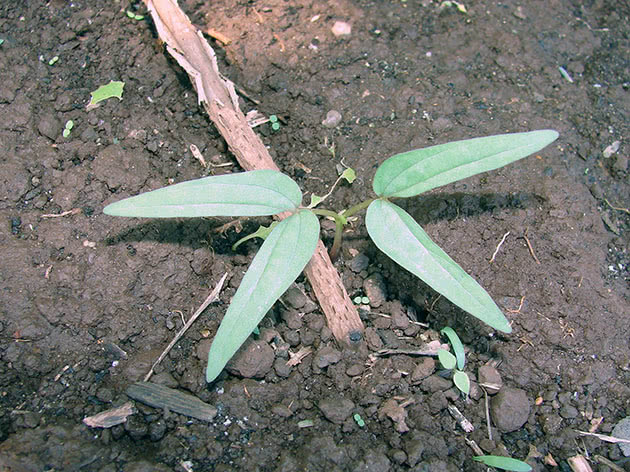

2.Ipomoea care
2.1 Growing morning glory - temperature
Ipomoea are thermophilic plants, they are suitable for room temperature in the warm season. During the dormant period in winter, place in a cool - about 7 ° C.
↑ Up,
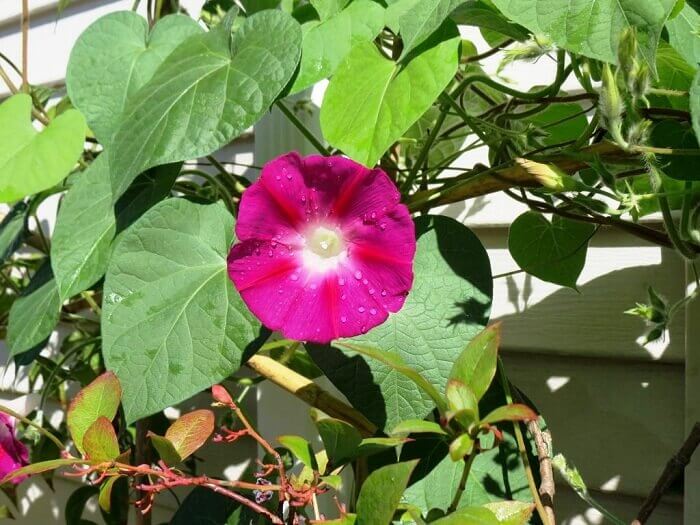

You may also be interested in:
- Kobey climbing - a photo of a flower, planting and growing from seeds in the open field, care at home, caring for seedlings, flowering time, what to feed, use of a plant in landscape design, description - what a liana looks like
- Lavatera - photo of a flower, planting and care in open ground, growing from seeds, planting seedlings, what a plant looks like, height, use in landscape design, soil for keeping in pots, how it blooms
- Nasturtium - a photo of a flower, growing from seeds, planting and care in the open field and at home, planting seedlings on a flower bed, keeping in pots, on the balcony and in the garden, flowering time, description of varieties
- Garden bindweed or birch - photo of a plant, planting and care in the open field, home care, flowering time, description, useful properties, soil for growing in pots, family, seedling maintenance
↑ Up,


2.2 Ipomoea home - lighting
The amount of light for morning glories varies from species to species, however most morning glories prefer a well-lit location with direct morning and evening sunlight. With a lack of light, flowering occurs later, the plant abundantly grows green mass. During the dormant period, lighting does not play any role. Ideally, the plant should be in the light until the buds form, and at the time when the flowers open, it needs to organize shading.
↑ Up,
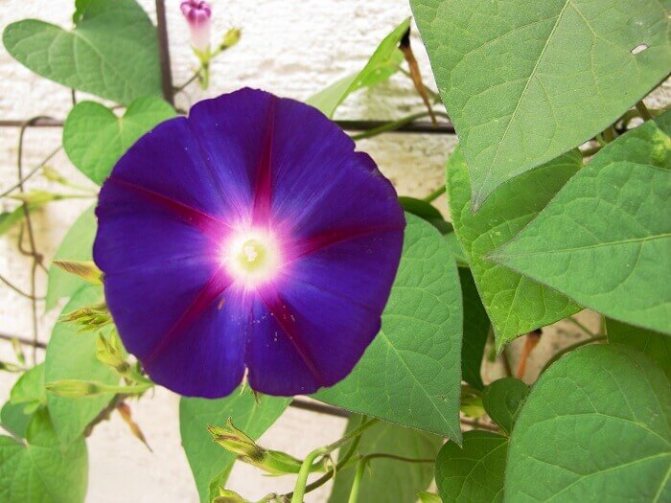

2.3 Ipomoea at home
Provide support for the long stems, which they quickly braid. Can be grown in hanging baskets, then the stems will run down in a beautiful cascade. An unpretentious plant that does not require special care. During the dormant period, the aerial part may die - in this case, the morning glory tubers are stored in dry sand until spring, when new growth begins from the root. Remove wilted flowers to extend the flowering period.
↑ Up,


2.4 Ipomoea in a pot - soil
Loose, nutrient-rich, well-drained soil.
↑ Up,
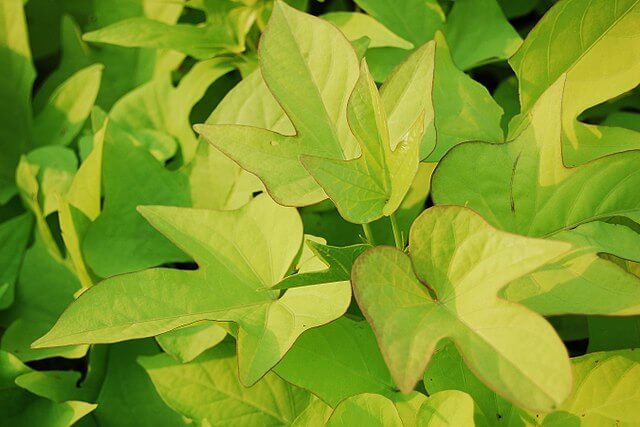

2.5 Top dressing
It is better to feed morning glories on the windowsill, in the stage of active growth, often - for example, every week, but fertilizers are diluted to half the recommended dosage. It is good to use fertilizers with a high potassium content.
↑ Up,
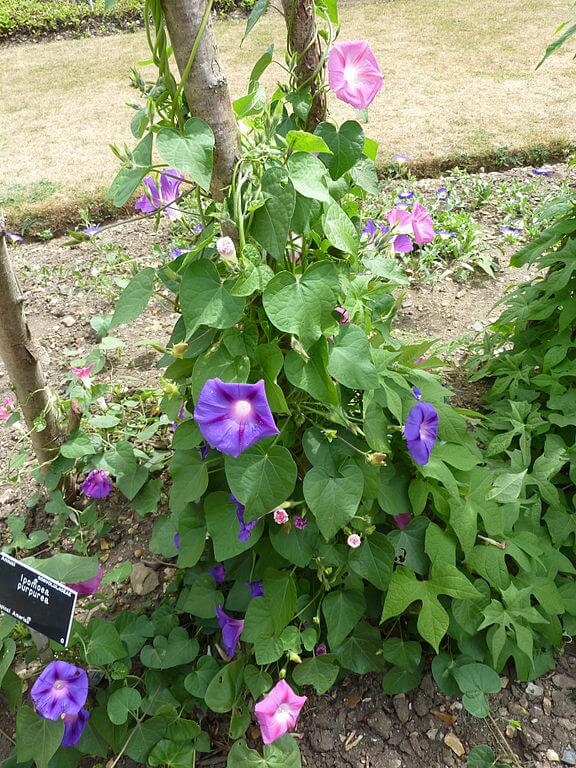

2.6 Purpose
Large blooming vine.
↑ Up,


2.7. Ipomoea flowering time
From mid-summer to frost.
↑ Up,
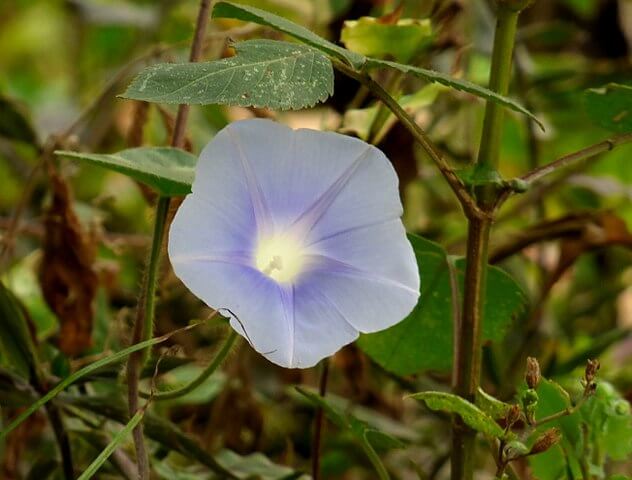

2.8 Air humidity
It tolerates dry air of living quarters well, but it is better to occasionally spray the leaves. Doesn't like cold drafts.
↑ Up,
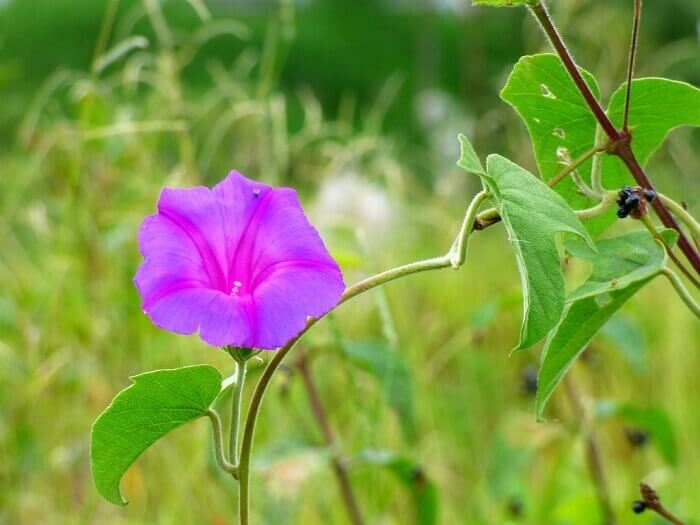

2.9 Soil moisture
During the growing period, morning glories need a lot of water, they should be watered regularly until the soil is completely soaked, however, allow the top layer to dry before the next watering. In winter, the tubers are kept almost completely dry.
↑ Up,
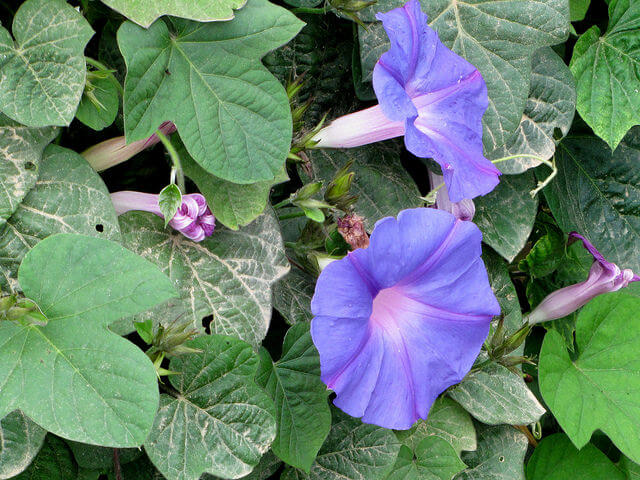

2.10 Ipomoea transplant
Sometimes this plant is thrown away after flowering and does not need replanting. Ipomoea tubers, grown as a perennial plant, are planted in spring in fresh soil.
↑ Up,
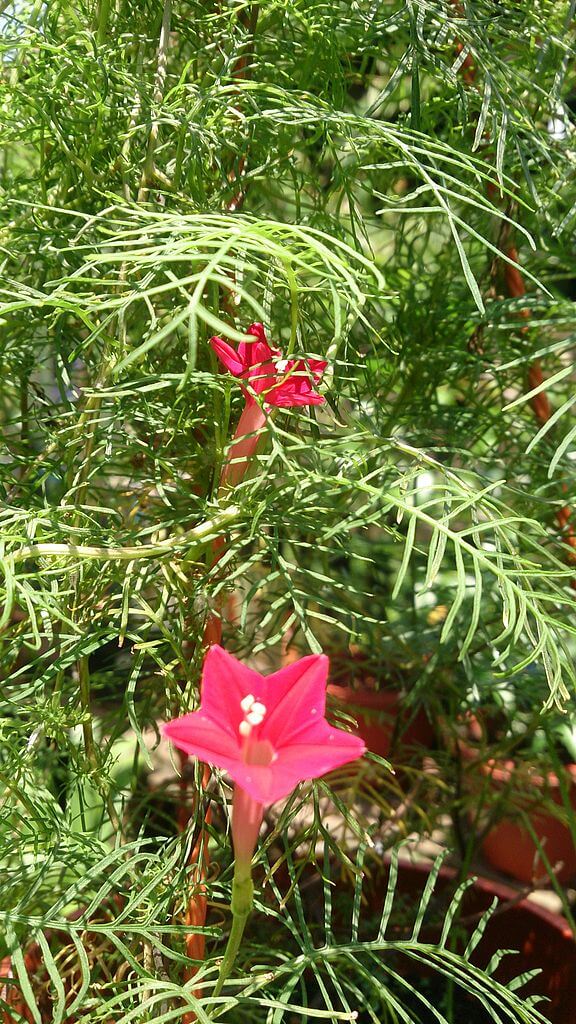

2.11 Ipomoea growing from seeds
Ipomoea are often propagated by seed sown in the spring - in March or April. The first sprouts appear within 1 - 2 weeks. You can pre-soak the seeds for a day in warm water. Apical cuttings. Remove the leaves from the lower ends of the cutting and dip the stems into rooting powder. Cover the young plants with a clear plastic hood or glass to maintain moisture and place in a warm, well-lit area without direct sunlight.
↑ Up,


2.12 Pests and diseases
Ipomoea slow down their growth when kept cool. The leaves wilt, and the tuber begins to rot with excess moisture.
From insects - pests sometimes appear aphids, whiteflies, spider mites.
Insects are pests
| Insect name | Signs of infection | Control measures |
| Whitefly | Small light spots on leaf blades, yellowing and foliage falling off. Disturbed white, small butterflies take off from the surface of the leaves | Chemicals: Zeta, Rovikurt, INTA-VIR, Fufanol and even Karbofos, Aktellik, Aktara, Confidor, Commander, Tanrek. Folk remedies: soap solution, garlic solution, infusion of yarrow and tobacco, infusion of dandelions, adhesive traps for adult insects |
| Spider mite | Subtle spider webs on the leaves, yellowing and falling foliage with extensive lesions. The surface of the sheet plates becomes dead and covered with small cracks. Plant development slows down. | Folk ways... Plants can be rinsed in the shower and left in the bathroom in a humid atmosphere for half an hour. Irradiation with an ultraviolet lamp every week for 2 minutes. Chemicals based on pyrethrum, sulfur powders, Fitoverm, Actellik. |
| Aphid | Sticky droplets appear on the leaf plates, the leaf plates curl up and deform, delicate buds and young leaves wither. Insect colonies can be seen on the tops of the shoots, buds or the underside of the leaf plates. The flowers of aphid-infested plants may become deformed. | Folk ways: infusion of nettle, decoction of rhubarb leaves, wormwood, soap solution, infusion of tobacco and dandelion, onion, marigold, yarrow, tansy, dusting with wood ash. Chemicals: Sulfur powders, treatment with green potash soap of green mass without getting into the ground, Decis, Aktellik, Fitoverm. |
↑ Up,
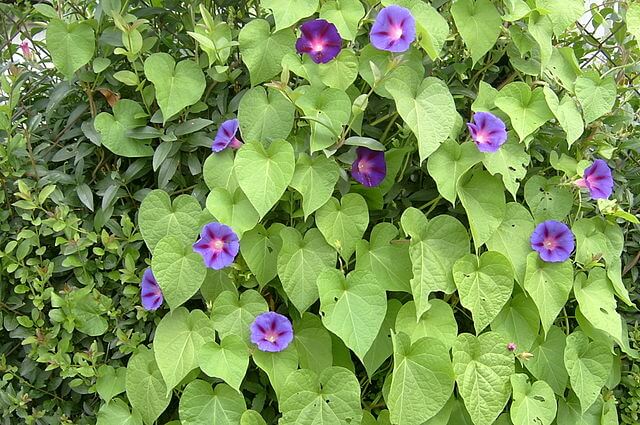

2.13 Note
Ipomoea seeds are toxic.
You may also be interested in:
- Lobelia - flower photo, planting and care, growing seedlings, keeping in open ground, in a flower bed, on a balcony and in a pot, flowering time of a house plant, transplanting
- Purslane - photo, planting and care in the open field, growing from seeds, medicinal properties, planting seedlings in a flower bed, keeping a perennial indoor plant in a pot, at home
- Passionflower - flower photo, home care, medical use, growing from seeds, flowering time, planting and growing in a pot, keeping in open ground, medicinal properties, description of indoor plants
- Hibiscus - photo, home care, reproduction, planting in open ground, why the leaves of a plant turn yellow, growing a shrub in a pot, varieties, useful properties
↑ Up,
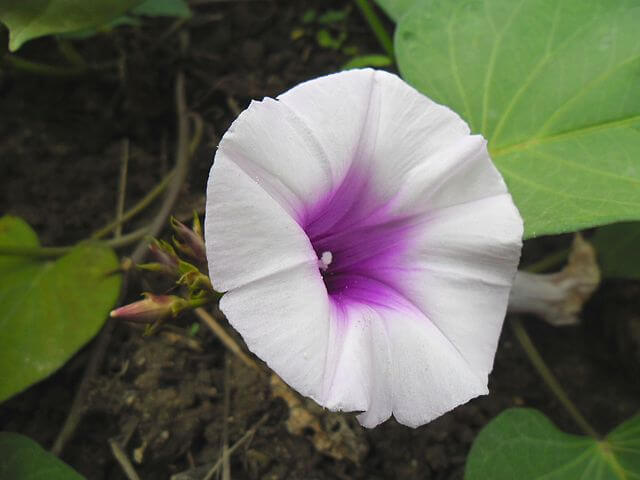

Hydroponics.
Pests and diseases of climbing morning glory
Liana does not attract insects too actively, since it is a poisonous crop. Most often, morning glory can be affected by pests:
- Whitefly. The larvae of this butterfly suck sap from the leaves, damaging their structure. Specialized chemicals and traps can help you get rid of the whitefly.
- Aphids, a characteristic sign of the appearance of which is the formation of yellow spots on the leaves. You can deal with insects with insecticides.
- A spider mite that appears with insufficient watering. First, together with the parts of the plant affected by the cobweb, the tick must be removed, then the bindweed must be sprayed with an insecticide and the watering must be increased.
Among the diseases, the formation of viral and fungal pathologies, white rust and various types of rot are often noted. In most cases, it is not possible to save the bindweed, therefore, in order to avoid contamination of neighboring plants, it must be removed from the site and burned.
Ipomoea ivy
This species received its name for the similarity of foliage with ivy leaves - the same voluminous, three-lobed and heart-shaped. The liana reaches 3 meters in height, the flowers are not too large - up to 5 cm in diameter. They are collected in small bunches of 2-3 pieces, the color varies depending on the variety - there are blue, pink and red specimens.
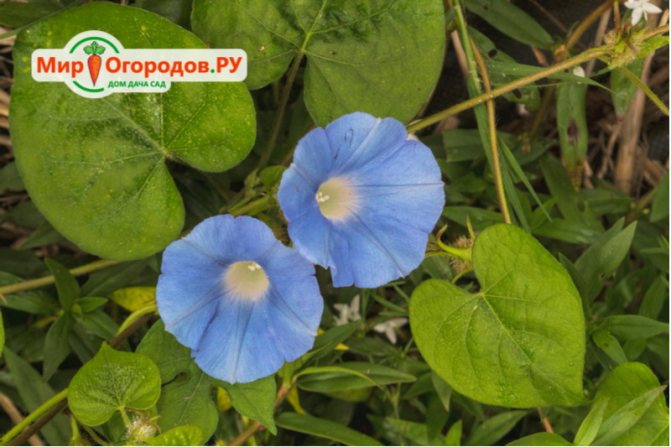

In the conditions of the Russian climate, the Roman Candy variety has earned great popularity, which easily adapted to it. Lianas of this variety grow up to 2.5 meters, the leaves are feathery, with a white-green color. The flowers are bright, cherry-white, rather large.
Varieties
The most common genus is called the sweet potato morning glory. It is represented by over 500 species. In floriculture, only 25 species are used. Breeders are constantly working to get new hybrid varieties of the plant, so over the years, a variety of options and colors appear.
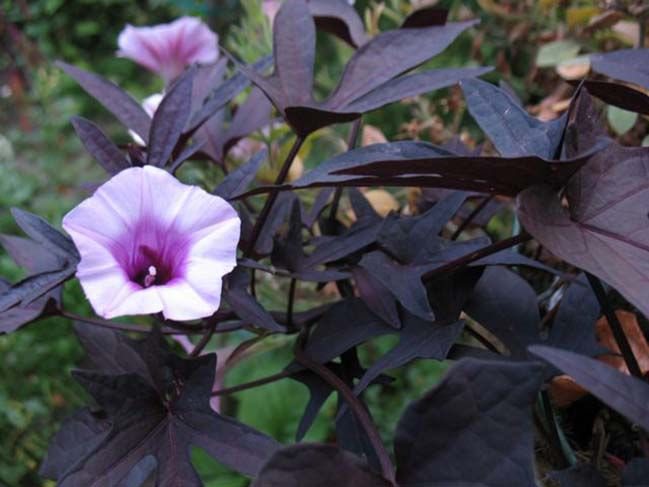

The sweet potato variety is resistant to a lack of moisture in the soil.
Some of the most commonly used species in gardens include:
Useful composition and recipes
Purslane - what kind of plant does it look like, description
The plant is rich in vitamins A, B, C, PP, iron, zinc, calcium, phosphorus, ascorbic acid.
For medicinal purposes (as a hemostatic, in the treatment of wounds, for constipation), decoctions of dried leaves collected at the end of summer are used.


For medicinal purposes, decoctions of dried leaves are used.
Tubers - sweet potatoes are used for food. They are useful for diabetes, digestive problems, and blood pressure disorders. Also recommended for the prevention of breast cancer, stomach.
Here are some recipes:
- To stop the blood, a teaspoon of finely chopped morning glory nodules is boiled in one and a half glasses of water for 10 minutes. After an hour, you can start taking 50 ml, 6 times a day.
- Laxative infusion is prepared from the roots of Mexican scammonia (Ipomoea orizabena) in the proportion: 1/2 teaspoon of roots in a glass of boiling water. Steamed in a thermos for two hours and drunk in two steps.
- To treat wounds, two tablespoons of tubers need to be poured with half a glass of boiling water and left for a couple of hours. Next, a compress is applied to the wound.
Also use the root infusion to rinse the hair.
Caution! Ipomoea-based products should not be used by children, pregnant and lactating women.
Potential harm
The flower also has harmful inclusions. Morning glory is not only beauty, but also danger. The milky sap in the stems of the plant contains alkaloids (in the same row with morphine, nicotine, quinine, and so on). And the seeds, although not in large quantities, contain psychotropic compounds. It is very dangerous if used uncontrolled, although small doses have been used successfully in medicine (for example, for pain relief).
Morning glory flowers are a relative of LSD. The availability of planting material for any person is especially frightening. It turns out a paradox: the seeds of morning glory are available, but the alkaloids in the composition are not.
A gardener who decides to have an morning glory in his garden, in a front garden or yard, can get both beauty and benefit at a low cost. Firstly, an impressive variety of varieties makes it possible to satisfy any request for decoration, secondly, the availability of the price of seeds allows a person with any income to purchase them painlessly, and thirdly, care is so easy that anyone can handle it.
Description
Some representatives have a lignified stem and a tree or shrub shape. When grown in temperate climates, it is considered an annual.
Young plants grow rapidly, forming large whips, strewn with flowers. Mature plants grow up to 3 meters, and some varieties even more.
The shape of the juicy green leaves is oval or heart-shaped. The size of funnel-shaped flowers in some varieties reaches up to 20 cm in diameter. The corolla opens early in the morning and fades by lunchtime. However, there are varieties with evening and night flowering.
Beautiful flowers of morning glory delight with flowering from June to the first frost. One gets the impression that the green carpet is strewn with bright phonographs. After flowering, the fruit is formed in the form of a box with several large black seeds. Morning glory easily spreads over the site by self-propagation. After falling into the ground, the seeds germinate quickly, and several young bushes have time to germinate during the season.
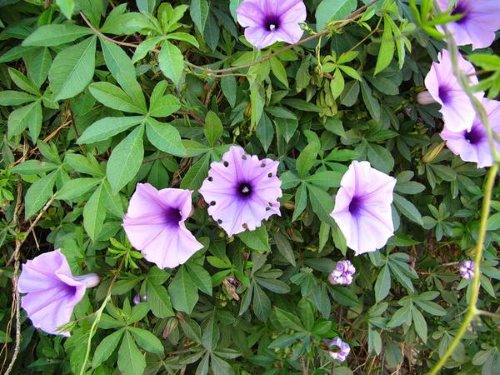

Morning glory of Cairo
General description of annual morning glory
Ipomoea grows in the form of a bush, grass, liana, or a short tree. This is a plant that is famous for the rapid growth of shoots reaching 5 m in length. As you can see from the photo of the annual morning glory, with their help the bindweed clings to various supports, turning nondescript objects into unique elements of country decor.
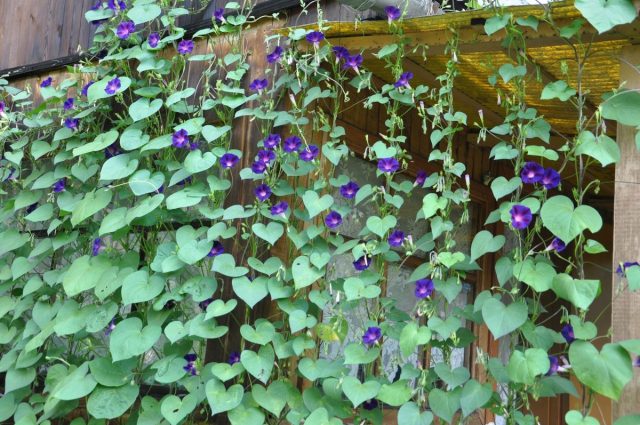

Funnel-shaped flowers grow on thin pedicels, their size, depending on the species and variety, ranges from 5 to 15 cm in diameter. There are monochrome and patterned flowers that can be painted in a wide variety of shades: such as white, blue, light blue, red, pink or purple.


Morning glory has a long flowering period. When old buds fall off, new flowers appear in their place almost immediately and boxes with seeds are formed. In temperate climates, for most varieties, flowering begins in June and ends in September, some varieties continue to delight the eye until the first October frost.
Liana can often be found in tropical and subtropical climates. In such conditions, the bindweed can develop and bloom for many years. However, due to the harsh winters in central Russia, morning glory is grown only as an annual plant.
Ipomoea is considered a thermophilic and light-loving plant that develops well in limed soil and prefers places illuminated by sunlight on a slight elevation. It reacts poorly to drafts, frosts, prolonged rains.
Planting and caring for the annual Ipomoea outdoors is fairly simple. Timely watering, loosening and weeding of the soil is important for her. Liana needs support, which can be used as a stretched wire or twine. The bindweed is fed with fertilizers containing potassium and phosphorus.
Important! Morning glory is poisonous. It can only be grown for decorative purposes in open areas.
Introduction
Liana-like morning glories are capable of braiding various supports and small structures with their stems and branches, while rising to a height of about 5 m. As a rule, these plants have a not thick, but very strong stem, capable of clinging to numerous irregularities and objects on the surface, or braiding supports, both artificial and natural.
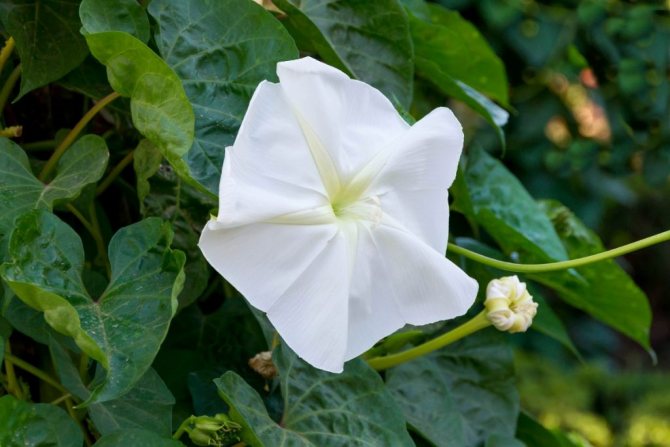

Ipomoea moonflower flower
Shrub forms, on the contrary, usually form small almost spherical bushes up to 60-70 cm in diameter. In rare cases, shrub forms have rigid stems that allow bushes to grow up to 3 m in height and about 1.2-1.5 m in diameter.
The growth rate of these plants is very high. Within one and a half, sometimes two months (as a rule, this period falls on May - the end of June), three or four plants are able to completely braid a gazebo with dimensions of 5 x 5 x 2.5 m.
In the same way, you can completely braid a fence or fence, freeing yourself from the views of neighbors, fill the window with leaves so that annoying sunlight does not enter it, braid the terrace to protect yourself from the sun. Well, and so on. Ipomoea is excellently suited as an annually renewed gardener.
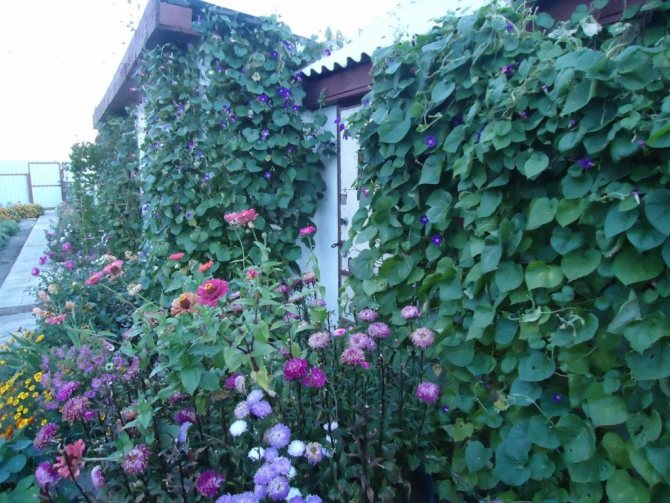

Braiding with the morning glory of the entrance to the house
But that's not all. The plant, thanks to its beautiful and bright flowers, has a wonderful decorative effect. Some species have so many flowers that the ground is often not visible under them. Ipomoea flowers can have a wide variety of sizes (from 1 to 10 cm) and colors (from white to dark purple). The flowering period of the plant is from 1 to 4 months, while most flowers do not last more than 6 days (and some bloom in general for only one day). A large number of flowers on a plant allows you to extend the flowering process almost until the first frost.
Some species of morning glory contain naturally occurring alkaloids in their stems and leaves, so they can be toxic to humans. Naturally, there is no question of poisoning, however, various allergic reactions are possible.
back to menu ↑
See also: Eustoma (Lisianthus) (100 Photos) - planting and care at home. An extraordinary plant in your garden + Reviews
Care
Adult vines are unpretentious in care. It consists of the following activities:
- Watering. Ipomoea is watered often, but in moderation. It is important not to allow the soil to dry out. At the same time, too abundant watering should not be allowed. This leads to decay of plants. To do this, you need to ensure that water does not accumulate at the roots;
- Pruning. In order for the vine to retain its decorative appearance, it is necessary to cut off weak, dried and diseased shoots in time. In the spring, molding pruning is done, during which no more than 3 shoots are left on the plant;
- Top dressing. In summer it is held every 2 to 3 weeks. Use a complex fertilizer for succulents or flowering plants. You can not abuse nitrogenous fertilizers. This leads to overdevelopment of lush foliage and a decrease in the number of flowers.
In order for the plant to be more branched, it is advisable to pinch young plants.
How to collect morning glory seeds
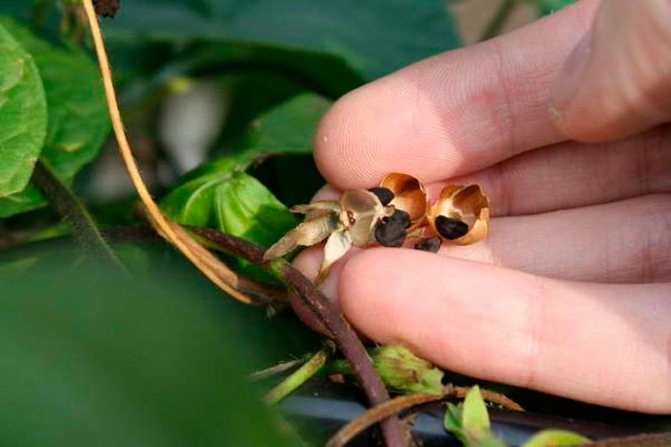

What time to collect seeds
Experts advise to collect seeds from the second and third buds. After the flowers wither, a brown box is formed in their place, wait until it dries and opens a little. This usually happens after 4 weeks. Pour the seeds into a paper bag with the name of the variety on it. The seeds remain viable for 3-4 years.
Drop off location
Every gardener strives to create the most comfortable conditions for a single plant. A place protected from winds and drafts would be ideal for impoei.Liana loves peace and quiet, first of all, because the wind can confuse the already tangled stems, it can tear the plant, ruin the flowers.


Ipomoea is also not happy with the abundance of light. You, of course, noticed how bright cheerful bindweed stars close and close their eyes closer to noon. The plant does not really like the dazzling rays, so it is better to feel and not to close the gramophone flowers longer, it will be in partial shade.
Reproduction of morning glory
The simplest and most convenient way to propagate morning glory is seed. Since plants are grown as annuals in temperate climates, the seeds are pre-planted for seedlings. If sown in March, they will bloom in mid-summer. Two days before sowing, they are soaked in warm (25-30 ° C), clean water. If the shell is not wrinkled, it is damaged with a file or a needle (scarified).
For planting, a mixture of garden soil with expanded clay and peat is used. The soil is poured into shallow boxes or peat cups. The seeds are buried by 1-1.5 cm. The soil is watered and the containers are covered with foil. The greenhouse is aired daily and the ground is sprayed. At a temperature of + 18 ... + 20 ° C, seedlings appear in 2 weeks. Seedlings 15 cm long begin to tie up so that the vine stretches out stronger. To get a lush bush at this age, pinch the top.
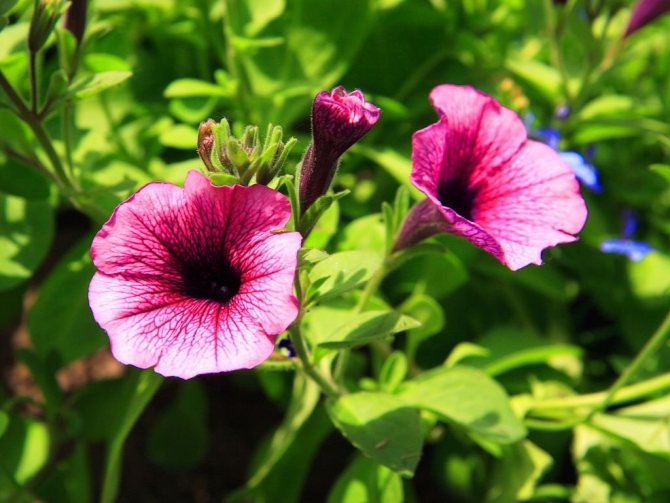

Perennial morning glory can be propagated by cuttings. To do this, in the spring, shoots are cut with a length of 15-20 cm. Each should contain 2-3 nodes. The lower cut is made at a distance of 1.5 cm from the node, at an angle of 45 °. The lower foliage is removed. Rooting is carried out in water at a temperature of + 20 ... + 25 ° C. With the appearance of the first roots, the plants are transplanted into sandy-peat soil. After a week, they will fully adapt and begin to develop faster.
How morning glory reproduces by cuttings
This flower is easiest to plant with seeds, but cuttings are sometimes used for this. To do this, you need to cut off young shoots. It is best to choose those with at least two internodes. The cut should be 2 cm below the knot. After cutting, the shoot should be in the water until the roots appear. This usually takes about a week. After the appearance of the roots, it is planted in the ground.


Hedge after flowering
Planting and leaving
Garden varieties of morning glory are fast-growing and unpretentious. They can be planted outdoors or grown on a balcony in containers. Seedlings are moved to the flower bed in late May or early June. The soil should warm up well, and frost should be completely avoided.
For the plant, you need to choose a sunny, open place without strong drafts. Gusts of wind can rip the vine off the support. The seedlings are distributed in shallow pits with a distance of about 20 cm. In order not to damage the roots, it is necessary to preserve an old clod of earth or plant the plants along with peat pots.
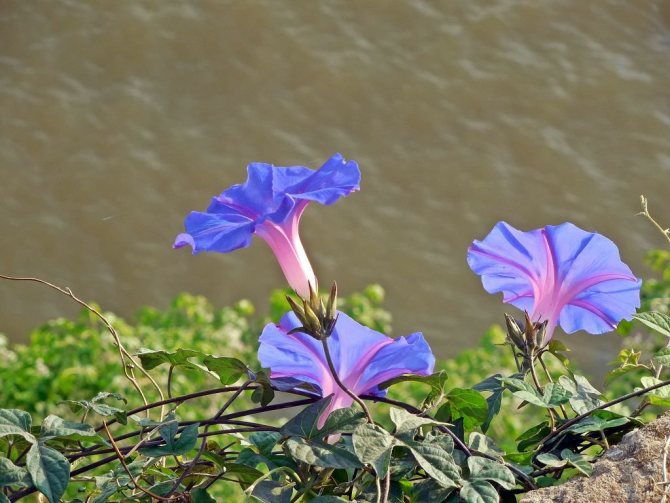

Immediately after planting, a support is formed in the form of a trellis, twigs or fishing line. To make the vine branch better, pinch the top of the main shoot. The soil for planting morning glory should be loose and fertile. A soil with a neutral or slightly acidic reaction is suitable. If necessary, peat, sand and deciduous humus are introduced into the ground.
Morning glory loves moisture. She needs regular and abundant watering. In the absence of natural precipitation, it is watered every other day. The surface of the soil should always be slightly damp, however, water stagnation is unacceptable. Since the beginning of September, watering is carried out less often, allowing the topsoil to dry out.
Plants are fed twice a month with a universal mineral complex for flowering plants. It is better to choose formulations with a low nitrogen content. Plants should be inspected periodically, cut off dry and broken branches, as well as wilted inflorescences.


In the fall, the garden morning glory begins to dry out. She will not be able to survive the frosty winter, so the vegetation is cut off and destroyed, and the site is dug up. On a warm balcony, morning glory can overwinter.For this, it is necessary to maintain the temperature around + 15… + 18 ° C and good lighting.
Morning glory has strong immunity. Only with prolonged flooding of the soil, dampness and low temperatures does the fungus appear. The main pests of the plant are spider mites and aphids. They settle on the leaves and drink all the juices. When small punctures and cobwebs appear along the edge of the leaf, it is necessary to carefully examine the entire plant and carry out treatment with an insecticide ("Aktellik", "Aktara", "Fitoverm").
Features of the
In many regions of Russia with severe snowy winters, only one-year-old morning glory is grown. This climbing plant blooms well and profusely from July to the first autumn frosts. Ipomoea flowers bloom quickly in the morning, and wither in the evening. True, long-term lush flowering is achieved due to constantly renewing flowers. Flowering - remontant and continuous.
It is completely unpretentious to care for, but poisonous culture. Propagated by seeds. Ipomoea is sown in open soil only in May. For seedlings - at the end of April. From the moment of sowing to the appearance of flowers, it takes about 2-3 months. If the bindweed does not bloom for a long time, it means that it is not properly looked after. In this case, you need to reduce the amount of dressings.
Morning glory is too sensitive to direct sunlight. Prefers diffused lighting. In northern latitudes, it can only be grown in greenhouses.
